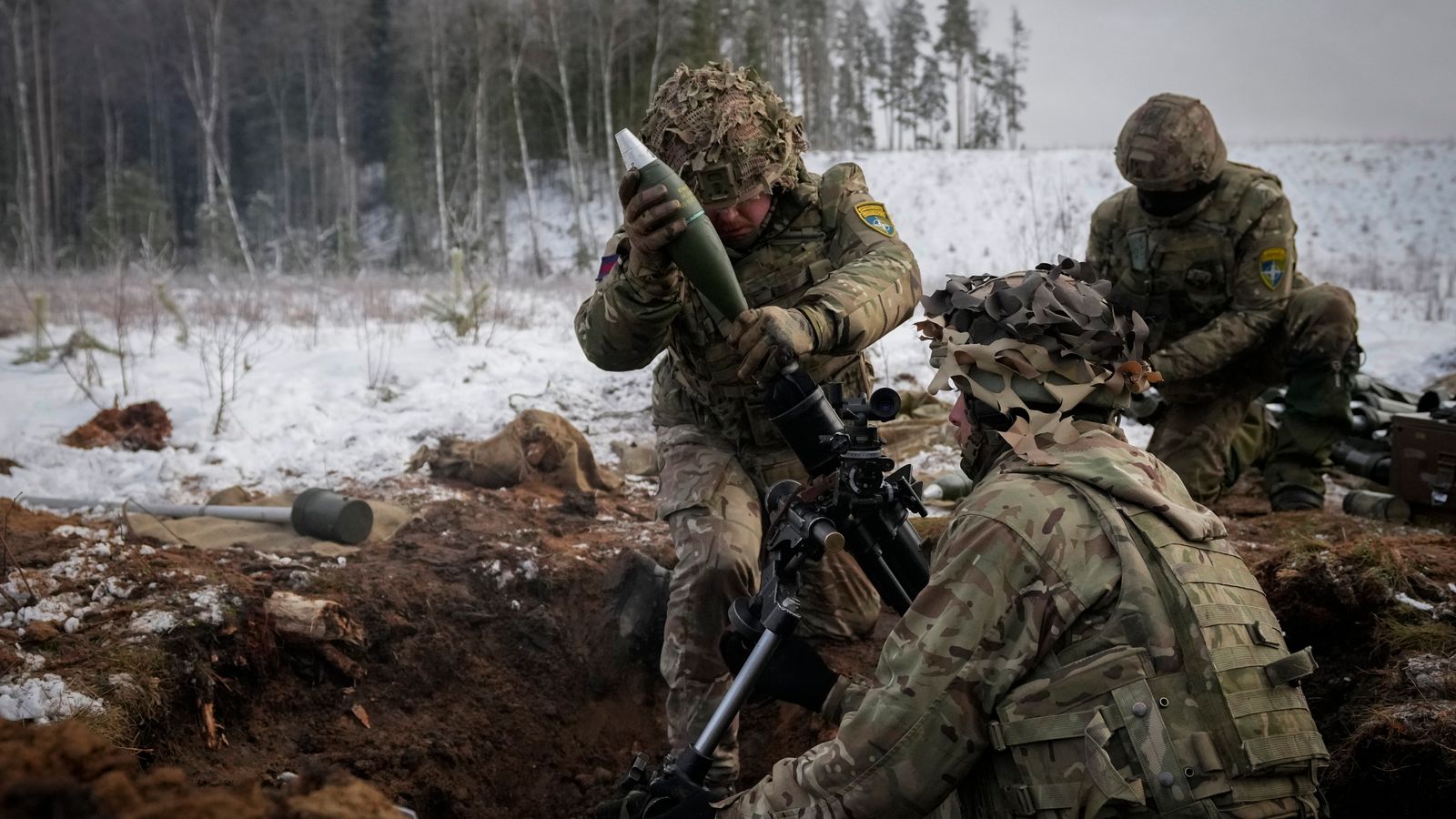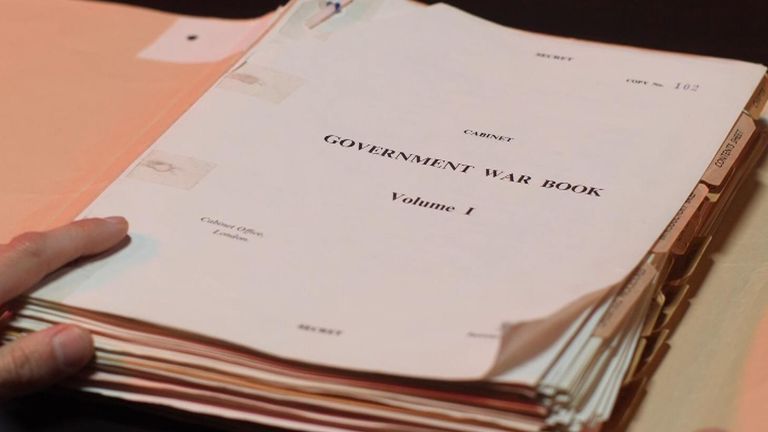The government has no national plan for the defence of the UK or the mobilisation of its people and industry in a war despite renewed threats of conflict, Sky News has learnt.
Officials are now starting to develop a cross-government “national defence plan”, it can be revealed.
Dr Keith Dear, a former RAF intelligence officer and expert adviser to the prime minister on science, technology and national security, argues below that it is reasonable for the public to assume there are detailed plans for any anticipated conflicts.
The US secretary of state warns we are “moving from a post-war to a pre-war world” and that “in five years’ time we could be looking at multiple theatres involving Russia, China, Iran and North Korea”.
The chief of the general staff, General Sir Patrick Sanders tell us that we are the “pre-war generation”.
The public might reasonably expect, therefore, that there are detailed plans, regularly refreshed, which would ensure we are prepared in advance for these anticipated conflicts, expected to be dramatically larger and more deadly than anything fought in recent memory – wars we might lose.
Surely, government departments, the Ministry of Defence, the Home Office, the intelligence agencies and our armed forces have a plan to know what to do when it starts, are structured according to the requirements, and can respond quickly?
Such plans are essential not only to avoid scrambling disorder and early defeats but also so that our adversaries, awed by our preparedness, are deterred from fighting in the first place.
The problem is, there is no plan.
We used to have one. Maintained by the government until the early 2000s, the central Government War Book sensibly detailed plans for the continuity of government in the event of war and a possible nuclear exchange.
It was needed so those of us who survived didn’t awake to anarchy.
The book also contained essential plans for mobilising the country in response to the imminent threat and outbreak of conventional non-nuclear war.
To this central Government War Book, a whole series of subordinate war books were developed and maintained by all departments – most obviously the Ministry of Defence, Home Office and Foreign Office – but even the BBC had a War Book plan to sustain broadcast communications to an anxious public.
These were not abstract and vague, but planned against the specific, anticipatable wars we might face.
Today, there are no such plans.
The Government War Book was developed by the first modern pre-war generation – those living in the years preceding 1918 – under the leadership of ex-Royal Marine and first cabinet secretary Maurice Hankey.
The War Book was interdepartmental, and detailed what needed to be done, where, and by whom, both in preparing for war should we reach the “precautionary stage”, and upon its outbreak the “war stage”.
A copy of the Ministry of Defence’s 1963 War Book in the National Archives shows it to be detailed, and comprehensive, referencing multiple tightly coordinated, supporting plans across the government and beyond.
In 1935, the last pre-war generation also worried war might come in five years. Consequently, our government then began to refresh the War Book in earnest.
Concurrently in 1935, the UK began building its military, and military-industrial preparedness.
For example, Lord Weir, the Scottish industrialist, was appointed to oversee a plan he had earlier proposed: building “shadow factories” adjacent to automotive factories, ready to manufacture aircraft at scale when war broke out.
The government thought deeper too, considering the need to be able to manufacture the machine tools on which factories would themselves depend, and those that could automate elements of manufacturing to speed up the rearmament effort and free up people for other tasks in the war effort, investing public funds accordingly.
The preparation was such that, after some dithering, on 23 August 1939, the government began to implement the pre-war “precautionary stage” of the plan.
Within a week, by 31 August, almost all the precautionary stage measures had been actioned. The War stage was actioned with the declaration of war a day later.
Today’s pre-war generation has had two warnings: first from COVID, and then from Russia’s renewed invasion of Ukraine.
The government’s response to the pandemic, where there was no plan worthy of the name, and mostly chaos for months, allows us to imagine what it would be like if war were to come without a plan to mobilise for it and to fight it.
Similarly, our inability to supply anything like enough munitions or weapons to Ukraine, shows also how hollowed out we have become by buying and building armed forces to no coherent war-fighting plan. Weapons without ammunition are useless. And we can’t know if we have the right weapons, either.
Click to subscribe to the Sky News Daily wherever you get your podcasts
If the secretary of state’s warnings of war sound alarmist, consider this: the director of the CIA suggests China seeks to be ready for an invasion of Taiwan from 2027.
The chair of the US House Select Committee says that 2027 may be the end, not the beginning of the window for when an attack on Taiwan is most likely.
A leaked internal memo suggests at least one four-star general in the US Air Force expects a war with China in 2025. In Europe, Estonian Prime Minister Kaja Kallas believes that Russia may threaten NATO‘s borders within three years.
Sweden’s civil defence minister and commander-in-chief warns Sweden must prepare for war now.
Even in what was until recently a deeply pacifist Japan, over 86% of citizens polled believe their country may have to go to war, while their government has doubled its defence budget.
The government would say there is a plan. Whitehall lists resilience frameworks, alert systems, risk registers and regular meetings.
What these things have in common is none of them amount to anything Hankey, or any reasonable observer, would regard as a plan – explaining what we think could happen, and specifically who needs to do what, when, to respond effectively.
The long disaggregated, disconnected nature of the various government artefacts speak of their own weakness, with commitments to what we will have done by 2030 and beyond. Not a plan for how to respond if X or Y happened tomorrow.
If we are five years from war, it is worth contemplating Lord Weir’s question, posed to the last pre-war generation in 1935: “Are we doing all we ought to anticipate by proper planning and arrangement the grave delays which were the feature of our almost fatal unpreparedness in 1914?”
Today, there is no plan. It is hard to imagine how we could be doing less.



